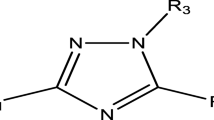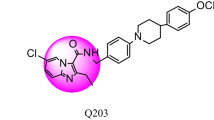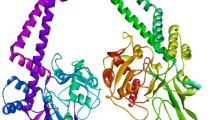Abstract
Multidrug-resistant strains of Mycobacterium tuberculosis still remain a major challenge in creating first-hand drugs for treating tuberculosis. Development and syntheses of novel compounds with more potent anti-tubercular agents are usually by the trial and error approach which is time consuming and expensive. QSAR is a theoretical approach which has the potential to reduce the aforementioned problem in discovering new potent drugs against M. Tuberculosis. This approach was employed to develop the multivariate QSAR model to correlate the chemical structures of the 1,2,4-triazole analogues with their observed activities using a theoretical approach. To build the robust QSAR model, genetic function approximation was employed as a tool for selecting the best descriptors that could efficiently predict the activities of the inhibitory agents. The developed model was influenced with molecular descriptors, AATS7s, nHBint3, minHCsatu, TDB9e, RDF90i and RDF110s which have been validated through internal and external validation tests. Molecular docking studies were also carried for all the studied compounds to show the interactions and binding modes between the ligand and the receptor (DNA gyrase). The lead compound (compound 34) with higher anti-tubercular activity was observed with prominent binding affinity of 21.9 kcal/mol compared to the recommended drugs: isoniazid (− 14.6 kcal/mol) and ethambutol (− 5.8 kcal/mol). Therefore, compound 34 served as a template structure to designed compounds with more efficient activities. Among the compounds designed, compounds 34p, 34q and 34r were observed with better anti-tubercular activities with more prominent binding affinities which ranges from − 24.3 to − 28.6 kcal/mol. The outcome of this research is recommended for pharmaceutical and medicinal chemists to synthesize and carry out an in vivo and in vitro screening for the proposed designed compounds to substantiate the computational findings.
















Similar content being viewed by others
References
Adeniji SE, Uba S, Uzairu A (2018a) QSAR modeling and molecular docking analysis of some active compounds against Mycobacterium tuberculosis receptor (Mtb CYP121). J Pathog 2018:1018694
Adeniji SE, Uba S, Uzairu A (2018b) A novel QSAR model for the evaluation and prediction of (E)-N′-benzylideneisonicotinohydrazide derivatives as the potent anti-Mycobacterium tuberculosis antibodies using genetic function approach. Phys Chem Res 6:479–492
Adeniji SE, Uba S, Uzairu A (2018c) Theoretical modeling and molecular docking simulation for investigating and evaluating some active compounds as potent anti-tubercular agents against MTB CYP121 receptor. Future J Pharm Sci 4:284–295
Adeniji SE, Uba S, Uzairu A (2019) Geometrical and topological descriptors for activities modeling of some potent inhibitors against Mycobacterium Tuberculosis: a genetic functional approach. Egpt J chem 62:1635–1647
Eric GM, Uzairu A, Mamza PAA (2016) Quantitative structure-activity relationship (QSAR) study of the anti-tuberculosis activity of some quinolones. J Sci Res Rep 10:1–15
Hansch C, Kurup A, Garg R, Gao H (2001) Chem-bioinformatics and QSAR: a review of QSAR lacking positive hydrophobic terms. Chem Rev 101:619–672
Ogadimma AI, Adamu U (2016) Analysis of selected chalcone derivatives as Mycobacterium tuberculosis inhibitors. Open Access Libr J 3:1–13
Roy K, Chakraborty P, Mitra I, Ojha PK, Kar S, Das RN (2013) Some case studies on application of “rm2” metrics for judging quality of quantitative structure–activity relationship predictions: emphasis on scaling of response data. J Comput Chem 34:1071–1082
Sarkar D, Deshpande SR, Maybhate SP, Likhite AP, Sarkar S, Khan A, Chaudhary PM, Chavan SR (2016) 1,2,4-triazole derivatives and their anti-microbial activity. Patient Google 2016
Singh P (2013) Quantitative structure-activity relationship study of substituted-[1,2,4] oxadiazoles as S1P1 agonists. J Curr Chem Pharm Sci 3:64–79
Tropsha A, Gramatica P, Gombar VK (2003) The importance of being earnest: validation is the absolute essential for successful application and interpretation of QSPR models. Mol Inform 22:69–77
Veerasamy R, Rajak H, Jain A, Sivadasan S, Varghese CP, Agrawal RK (2011) Validation of QSAR models-strategies and importance. Int J Drug Des Discov 3:511–519
World Health Organization (2018) Tuberculosis fact sheet (no. 104) 2000. http://www.who.int/newsroom/factsheets/detail/tuberculosis
Author information
Authors and Affiliations
Corresponding author
Additional information
Publisher's Note
Springer Nature remains neutral with regard to jurisdictional claims in published maps and institutional affiliations.
Electronic supplementary material
Below is the link to the electronic supplementary material.
Rights and permissions
About this article
Cite this article
Adeniji, S.E., Uba, S. & Uzairu, A. Multi-linear regression model, molecular binding interactions and ligand-based design of some prominent compounds against Mycobacterium tuberculosis. Netw Model Anal Health Inform Bioinforma 9, 8 (2020). https://doi.org/10.1007/s13721-019-0212-6
Received:
Revised:
Accepted:
Published:
DOI: https://doi.org/10.1007/s13721-019-0212-6




